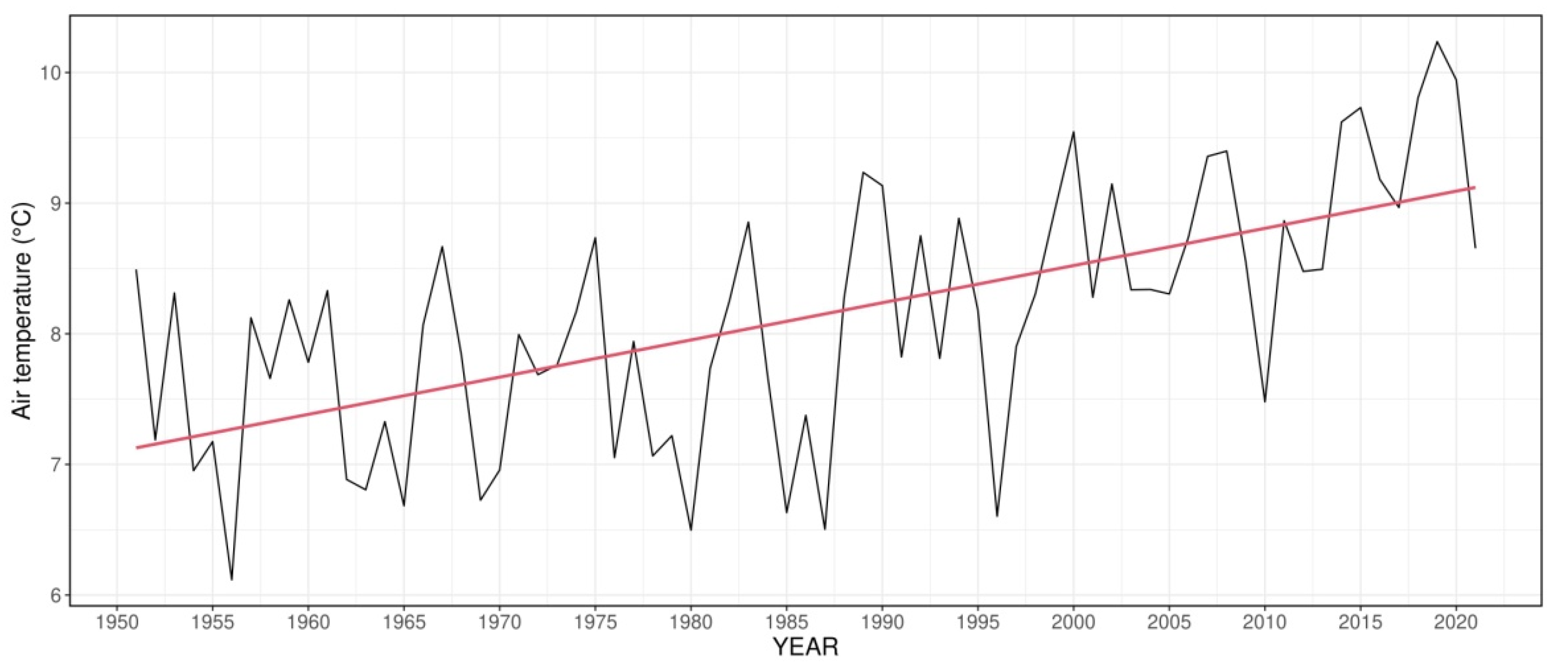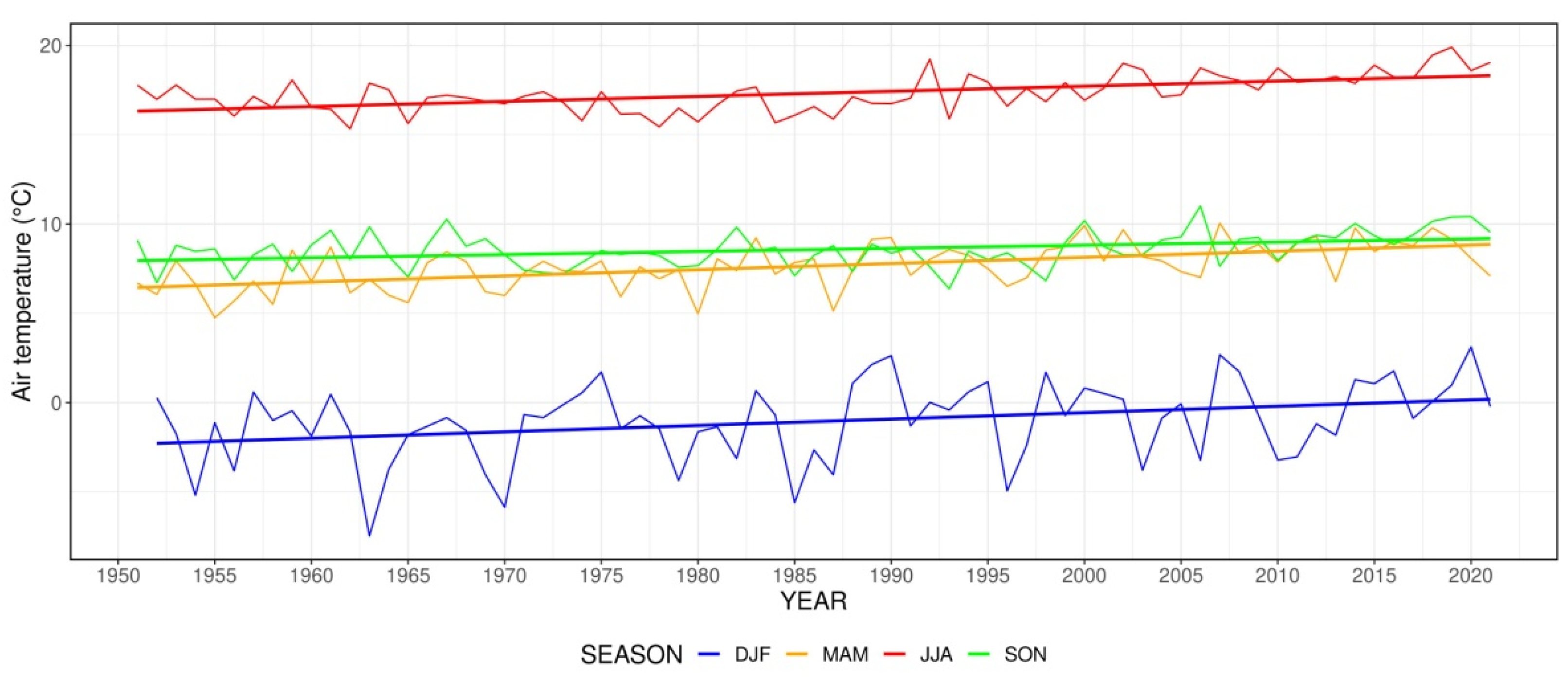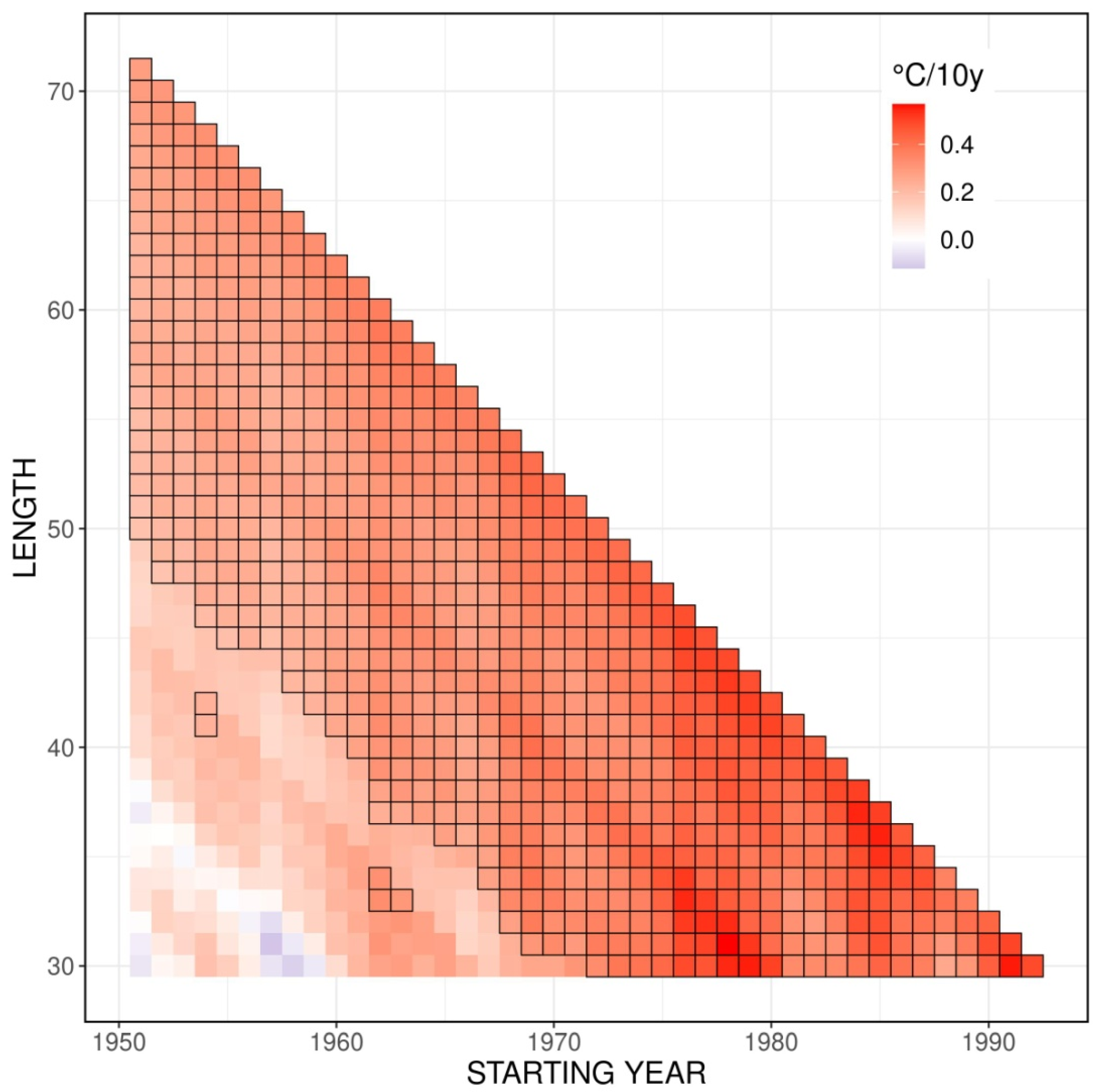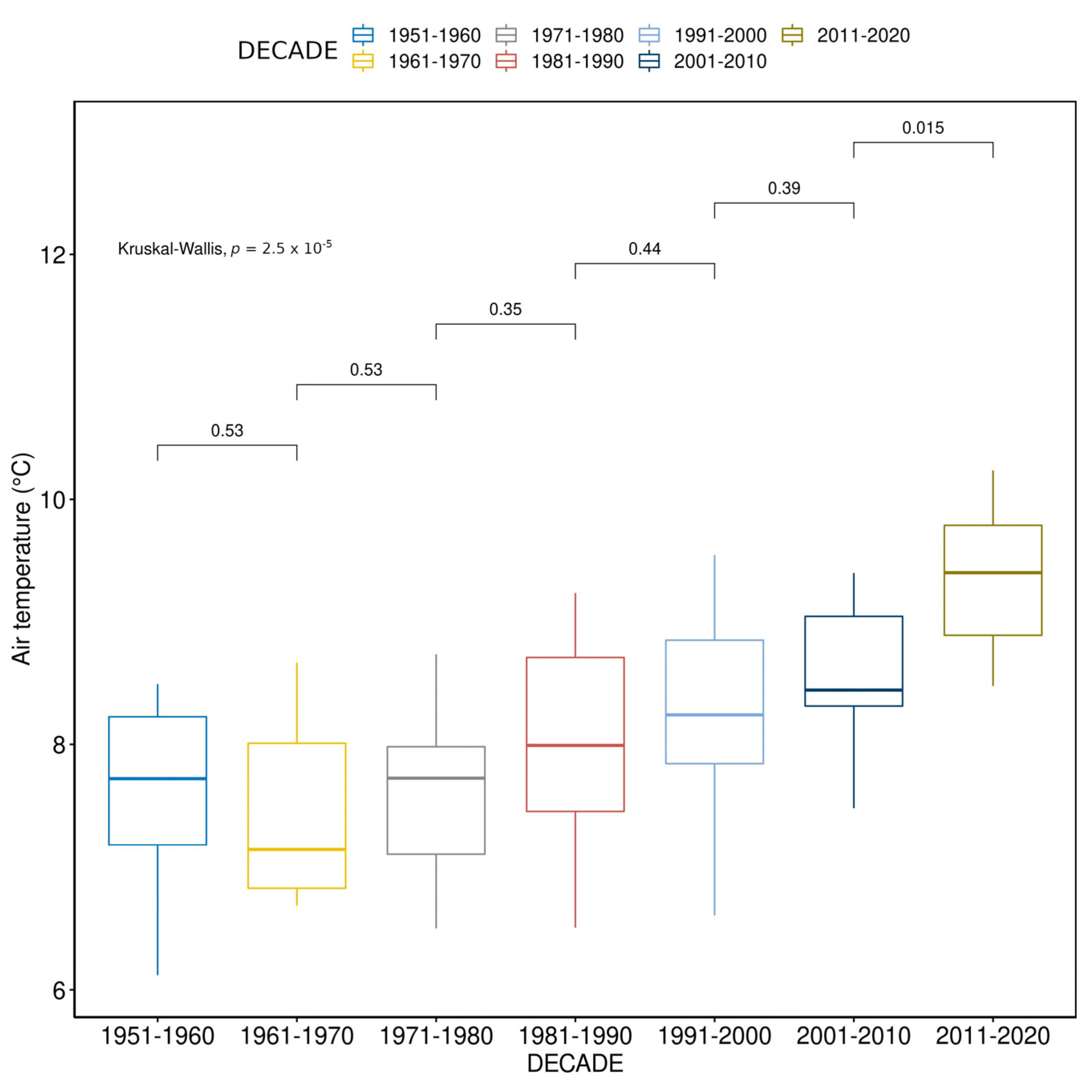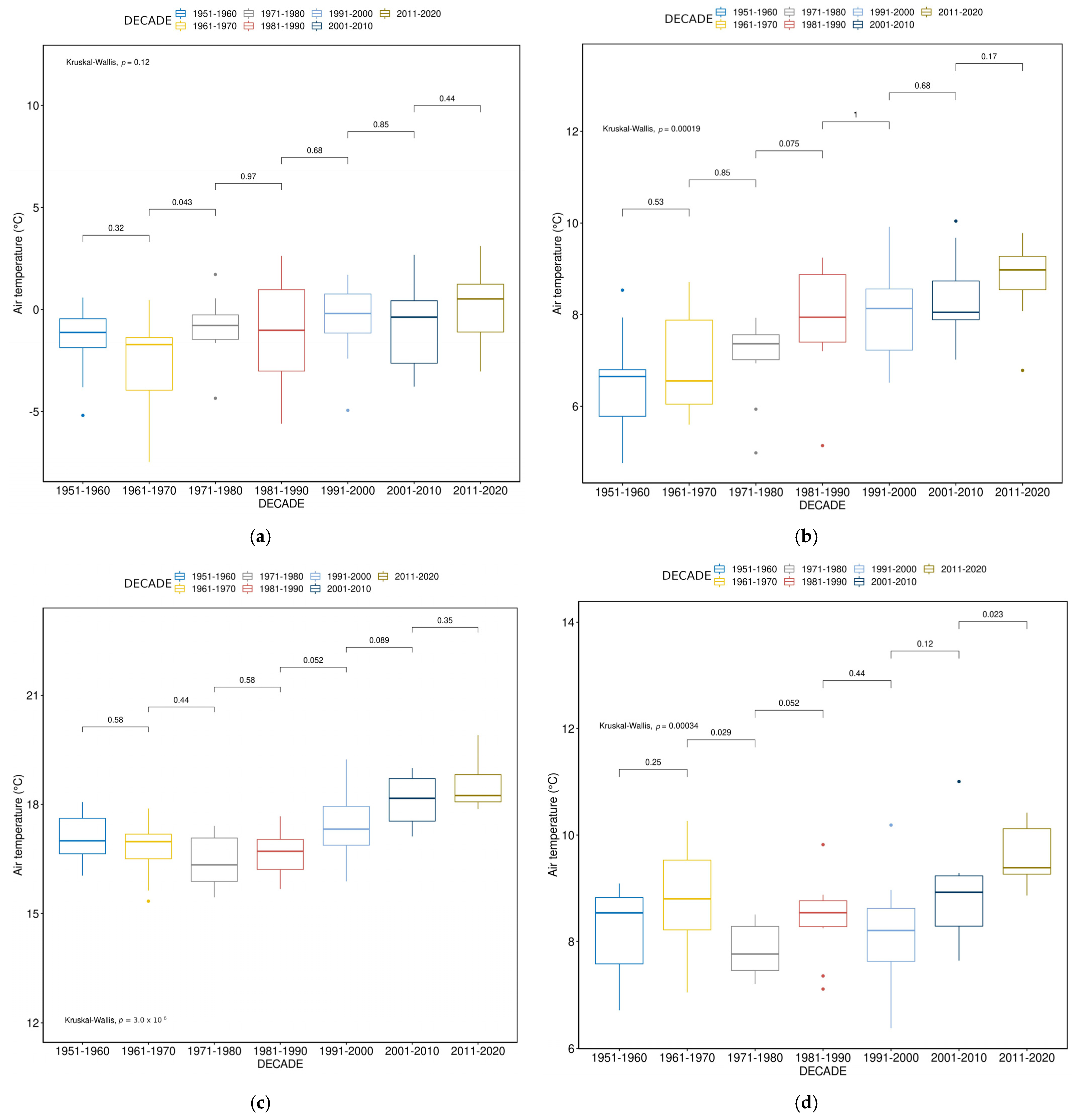3.1. Overall Characteristics
The average air temperature in Poland over the last 71 years (1951–2021) was 8.1 °C (
Table 1) (same value for 1951–2020) and 8.7 °C for the last normal period, 1991–2020. The recorded variability of Poland’s average annual air temperature ranged from 6.1 °C in 1956 to 10.2 °C in 2019 (amplitude exceeded 4 °C).
In seasonal scope, the winter season range of recorded values (10.6 °C) exceeded twice the range of annual variability. In comparison with winter, the range values were much lower in spring (5.3 °C), summer (4.6 °C), and autumn (4.6 °C). The lowest temperature of the winter period (−7.5 °C) occurred in 1963, whereas the highest (3.1 °C) occurred in 2020. The result is a range of air temperature exceeding 10 °C.
From spring to autumn, the range of values is close to 5 °C. A slightly higher value appears in spring (5.3 °C), with the lowest temperature of 4.8 °C (1955) and the highest 10.0 °C (2007). In summer and autumn, the range value is 4.6 °C.
The average seasonal (1951–2021) spring temperature is 7.6 °C. In summer, it is 17.3 °C, and in autumn, it is 8.6 °C. For the latest normal period (1991–2020), average temperatures for winter, spring, summer, and autumn are −0.4 °C, 8.4 °C, 18.0 °C and 8.9 °C, respectively. The ranking of years of average annual air temperature indicates that 9 years from the first two decades of the 21st century (2001–2021) are in the top ten of the warmest years recorded since 1951. In the case of the winter season, it is 5 years; spring, 6 years, and 9 years; and for autumn, 6 years.
3.2. Annual and Seasonal Anomalies
A significant change in thermal characteristics was confirmed by the analysis of the course of annual and seasonal anomalies of the average area air temperature in Poland with reference to the 1991–2020 normal values (
Figure 2).
A characteristic feature is the occurrence of increasingly higher anomalies values in the last 21 analyzed years (2001–2021), especially when compared with the period before 2001. There is significant year-to-year variability in the winter season, especially striking when the years with high negative anomalies, such as 2006 (−2.9 °C), are adjacent to the +3.0 °C anomaly (2007). Other examples would be 1997 and 1998, with anomalies of −2.0 °C and +2.0 °C, respectively. Such year-to-year changes in winter thermal conditions are usually the result of atmospheric circulation variability [
9]. It should be emphasized that the significant variability of the air temperature in winter is not limited to the last 20 years, but occurred throughout the analyzed period. The last two decades show a much more frequent occurrence of high positive anomalies approaching or exceeding +2.0 °C (2019, 2016, 2007, and 2008). Additionally, significant positive anomalies (+3.0 °C in 1990) are characteristic for the end of the 1980s and the early 1990s when, from 1988 to 1994 (excluding 1991), repetitive positive air temperature anomalies were recorded. Twelve out of twenty-one winter seasons since 2001 were characterized by temperature values above the long-term average. The highest negative anomaly (−7.1 °C) was recorded in 1963, and the highest positive was +3.5 °C in 2019.
Other seasons are not characterized by such a significant variance in air temperature anomalies. In spring, the anomalies range from −3.6 °C (1955) to +1.7 °C (2007), with only a slightly lower value (+1.4 °C) recorded in 2019 and 2014. Additionally, in this season, positive anomalies are much more frequent in the 21st century (12 out of 21 cases), while in the 50-year period (1951–2000), only 10 such cases occurred. In the summer season, the anomaly values range from −2.7 °C (1962) to 1.9 °C (2019). In the case of this season, from 2001, as many as 15 of 21 summer seasons were characterized by positive anomalies. The lowest temperature in the autumn season (anomaly −2.5 °C) was recorded in 1993, and the highest (+2.1 °C) in 2006. As was the case with the summer season, 15 of 21 autumn seasons in the 21st century were characterized by temperature values higher than the long-term average (1991–2020). It should be noted that also in the 1960s, anomaly values approaching or exceeding +1.0 °C were recorded (1967, 1963, and 1961 with anomalies of +1.4 °C, +1.0 °C, and +0.8 °C, respectively). The results clearly show the positive change in the thermal conditions and the increase in its intensity in the 21st century, which is in concordance with other aforementioned research outcomes.
3.3. Trend Analysis
The rate of changes in air temperature in Poland over the last 71 years was 0.28 °C per decade, and in the course of the average area air temperature, years with values exceeding 9.5 °C (
Figure 3) clearly stand out (2019, 2020, 2018, 2015, and 2014).
It is also notable that since the beginning of the 21st century (except for 2010), the average annual air temperature has not fallen below 8 °C. For the last decade (2011–2020), it was 9.3 °C, which was the warmest decade from 1951. The recorded trend (1951–2021) is statistically significant, indicating the permanent (in long-term perspective) nature of observed variability. Positive, statistically significant trends also occur in seasonal scope (
Figure 4).
For 1951–2021, the highest rate of change was recorded in winter (0.36 °C per decade). Slightly lower rates (0.35 °C/decade) occurred in spring, whereas in summer, it was close to the variability for the average annual temperature (0.29 °C/decade). Autumn is characterized by the lowest value of the trend coefficient, 0.18 °C/decade. It should be noted that temperature variability is relatively low in the case of spring, summer, and autumn compared with the winter season. The above rate of change is consistent with the results of analyzes by Ustrnul et al. [
2] based on daily homogeneous series of maximum, minimum, and average temperature data for the period 1951–2018 originating from 58 meteorological stations in Poland.
The above variability analysis clearly confirmed the general changes recorded over the decades. The analysis of variability and trends in a long time scale (1951–2021—the maximum data series length available from the data) does not necessarily enable reference to the direction of change in the shorter periods of time, e.g., the last 30 years. For this purpose, an analysis of the trend coefficients was carried out for all possible series of air temperature data in Poland (not shorter than 30 years). Calculations were carried out both for annual temperature averages as well as seasonal values. The coefficients of the trend equation were calculated, and the statistical significance was verified using a non-parametric Mann–Kendall test.
The results are presented as matrices of trend slope values, with additional statistical significance markings (
Figure 5 and
Figure 6). Analysis of the set of trend coefficients for annual average temperatures shows a relatively uniform pattern with positive and statistically significant trends (
Figure 5), especially for long time series starting from the 1970s. However, the beginning of the analysis period does not show statistically significant trends even for time series up to 49 years (e.g., 1951–1999). In some cases, at the beginning of the analysis period, 30-year coefficients exhibit negative tendencies (e.g., 1958–1987) although it must be emphasized that those coefficients are not statistically significant. As mentioned earlier, the overall 71-year annual temperature trend coefficient equals 0.28 °C/decade, but its variability in starting year/length combinations is significant. In the following analysis, only statistically significant coefficients will be considered. The lowest values (0.18 °C/decade) were recorded at the beginning of the analysis period and for series lengths of around 45 years. The highest reaching 0.57 °C/decade was recorded for 30 years trends, starting in 1975–1980. Values of trend coefficients exceeding 0.5 °C/decade appear for short time spans beginning in the early 1990s, with the highest value of 0.56 °C/decade for the 1991–2020 period, which indicates the recent rapid increase in the annual air temperature increase. Overall, annual values exhibit a robust upward trend without any interruptions, at least from the 1970s.
In seasonal scope (
Figure 6) in winter, the variability of the trend coefficients is even more pronounced with minimal values (non-significant) below −0.3 °C/decade (1988–2017, 1957–1987). However, those occurrences are restricted to periods starting in the late 1950s and late 1980s with a length between 30 and 35 years. The highest recorded positive trend coefficients in some cases exceeding 1.0 °C/decade occurred for the time series beginning in the early 1960s for a length between 30 and 40 years. Those were statistically significant. What strikes is the pattern that begins in the early 1960s when there are multiple significant trends for lengths from 30 to 60 years, indicating robust tendencies. Those may be associated with the atmospheric circulation patterns such as NAO, which governs the thermal characteristics of the winter season in Poland. For subsequent years (from around 1965), the trends are positive but not significant (with the exception of the longest periods), and for the series beginning in the early 1970s with a length of around 40 years, the values of the coefficients only slightly exceed 0 °C/decade. The 1952–2021 trend coefficient equals 0.36 °C/decade. The latest normal period (1991–2020) trend equals 0.48 °C/decade (not significant, which suggests high year-to-year variability in the drivers of the winter thermal characteristics, e.g., significant variability of NAO in the second decade of the 21st century.
In spring, there is a robust and uniform pattern of positive values of trend coefficients (no negative values). A minimum (0.02 °C/decade) occurs for the 1959–1988 period. Maximum values exceeding 0.5 °C/decade occurred for periods beginning in the mid-1970s for relatively short period lengths (up to 40 years). The latest 30–35 year-long trends ending in 2021 are mostly statistically insignificant. The trend for the 1991–2020 period equals 0.42 °C/decade. The 2021 spring was very cold and dragged down the trend coefficient to 0.25 °C/decade (not significant).
Summer, a season when there was a significant shift from negative trends’ coefficients for periods beginning in the 1950s, and lasting up to 40 years to highly pronounced positive trends with the values of coefficients exceeding 0.7 °C/decade for periods starting in the late 1970s with lengths up to 40 years. What is apparent is the fact that for longer time series starting in the 1950s, only those of approximately 60 years in length tend to be statistically significant. In contrast, since the mid-1970s, air temperature variability exhibited a positive statistically significant trend for all possible time series lengths. The last 30-year normal period trend coefficient (1991–2020) is 0.52 °C/decade, nearly twice as high as the 71-year trend (1951–2021) at a level of 0.29 °C/decade.
As stated above, the 1951–2021 Autumn trend coefficient is the lowest (season-wise) and equals 0.18 °C/decade. Autumn is also a season when a substantial part of the trend coefficient spectrum shows negative tendencies (non-significant, though). This is characteristic for periods from the 1950s until the late-1960s. For trends starting in the early fifties, negative coefficients occur for a series as long as 50 years (e.g., 1951–2000). Since the 1970s, positive trends have appeared, and there is a robust pattern of positive trends (statistically significant). The latest 30-year trend reaches (1991–2020) 0.77 °C/decade, which is over four times higher than the 71-year trend coefficient. This also means that Autumn is the quickest warming season in the 1991–2020 period. The above analysis confirms, on the one hand, the overall positive tendencies recorded in the air temperature variability. On the other shows the nonuniformities of those. In general, there is a persistent positive trend in the annual temperature which increased its pace in the last 30 years. Seasonal characteristics show some deviances from this pattern. This is mostly visible in winter when the trends are the least stable, exhibiting changes in pace and direction of change. What is worth mentioning is that the latest 30 year series does not exhibit a significant trend in this season. The trend coefficient patterns in spring, summer, and autumn are more stable with the most uniform positive values recorded in spring.
3.4. Decadal Comparison
Table 2 shows the decadal variability in the thermal characteristics of Poland and is subsequently accompanied by the result of non-parametric Kruskal–Wallis and Wilcoxon tests (
Figure 7 and
Figure 8). Results (
p values) of the overall Kruskal–Wallis test and Wilcoxon test for inter-decadal differences are provided.
The overall pattern of temperature variability shows a substantial change in air temperature. Comparing annual decadal averages, one sees that the difference between the 2011–2020 and the 1951–1960 periods is 1.7 °C (from 7.6 °C to 9.3 °C). This change was similar in the case of other statistical characteristics (5%, 95% quantiles and median). Only for the 5% quantile did it reach 2 °C. Relatively identical patterns with increasing values occur in other seasons. The highest change in averages (2.3 °C) was recorded in spring, whereas the lowest (1.4 °C) was recorded in autumn and summer. In winter, the difference equals 1.7 °C. In the case of 95% quantile marking the extreme values, the change in annual values is 1.7 °C, whereas in seasonal scope, it ranges from 1.4 °C in autumn to 2.0 °C in winter. The investigation of the significance of overall and decade-to-decade changes suggests that the overall air temperature change has been relatively gradual until the last decade. In the case of both annual and seasonal analyses, the Kruskal–Wallis tests results are mostly unequivocal. They indicate that the overall change in thermal characteristics between decades is statistically significant. The exception is winter, when the change is not statistically significant. This is in concordance with the trend coefficient analysis, which shows that the variability of thermal conditions in winter is the most unstable.
As for the inter-decadal changes in the case of annual temperatures, only the shift from 2001–2010 to 2011–2020 is statistically significant. Over the seasons, such shifts occur in winter (1961–1970 to 1971–1980) and autumn (1961–1970 to 1971–1980, and 2001–2010 to 2011–2020).


